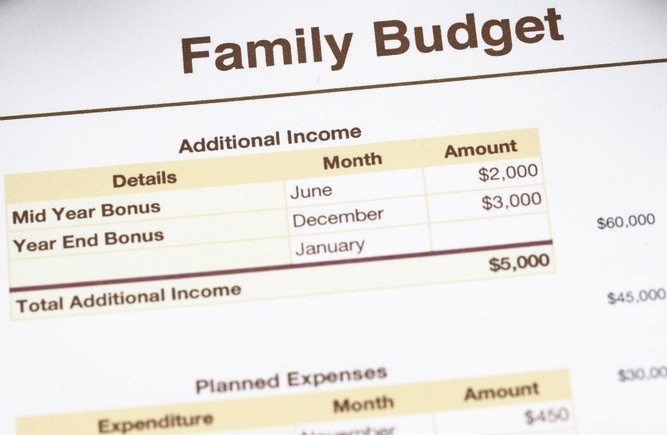Many of us have been there – running out of money a week before receiving your next pay check or not having enough to pay your monthly bills. Before you know it, out comes the credit card to pay for every day expenses or incur other types of debt. Creating a budget helps you deliberately plan when, where, and how you spend your income.
A budget allows you to determine exactly how much money you can afford to spend for each area your household and personal life. The project occurs in to two steps: 1) create the budget and 2) Implementing the budget.
Creating Your Monthly Budget
- Start the process by totaling the take-home pay from all sources – wages, interest, social security, or other government assistance. Enter the amount at the top of your worksheet.
- List your expenditures and expenses but only essential items, such as mortgage, car payment, utility bills, and food and debt payments.
- Subtract these expenses from your monthly income. The money you have after accounting for essential expenses represents discretionary income.
- List categories for discretionary spending, which may include entertainment, eating out, personal care items, clothes or books. You should also designate money for savings, which include an emergency fund, vacation, holiday fund, or large purchases. Look at your expenditures for the past several months to get a realistic picture of your discretionary spending habits. Use the average amounts to determine to plug into your budget worksheet.
- Review all the figures to ensure you account for all items on both the necessary expenses and discretionary spending lists. Make sure total expenditures do not exceed your household income.
Implementing Your Monthly Budget
Document the amount of expenses you will pay by check, debit card, or automatic withdrawals. Subtract the total for these bills from your income. If you have a monthly income of $3,500 and the bills you subtract from your checking account totals $2,700, you have $800 remaining for cash expenditures.
Label a plain white envelope with the name for each cash category, such as groceries, clothing, gas money, or entertainment and the amount.
Withdraw cash from your checking account at the beginning of the month and put the correct amount in each envelop. Spend the money only for items listed under the envelop category.
After you finish spending the money designated for a category, you cannot spend on that category until you start over the following month.
The envelop system of budgeting represents just one of many budgeting techniques you can employ to help manage your finances more efficiently.
Other Budgeting Tips
After you create the budget and implement it, review it each month, which can help you stay on track. Compare expenses from month- to-month and make adjustments in spending to help balance the income and expense columns on your worksheet.
Individuals who find it challenging to budget their own finance can seek help from a financial adviser. These professionals can help identify areas where you may squander money and how you can put your funds to better use.
Many of us have been there – running out of money a week before receiving your next pay check or not having enough to pay your monthly bills. Before you know it, out comes the credit card to pay for every day expenses or incur other types of debt. Creating a budget helps you deliberately plan when, where, and how you spend your income.
A budget allows you to determine exactly how much money you can afford to spend for each area your household and personal life. The project occurs in to two steps: 1) create the budget and 2) Implementing the budget.
Creating Your Monthly Budget
- Start the process by totaling the take-home pay from all sources – wages, interest, social security, or other government assistance. Enter the amount at the top of your worksheet.
- List your expenditures and expenses but only essential items, such as mortgage, car payment, utility bills, and food and debt payments.
- Subtract these expenses from your monthly income. The money you have after accounting for essential expenses represents discretionary income.
- List categories for discretionary spending, which may include entertainment, eating out, personal care items, clothes or books. You should also designate money for savings, which include an emergency fund, vacation, holiday fund, or large purchases. Look at your expenditures for the past several months to get a realistic picture of your discretionary spending habits. Use the average amounts to determine to plug into your budget worksheet.
- Review all the figures to ensure you account for all items on both the necessary expenses and discretionary spending lists. Make sure total expenditures do not exceed your household income.
Implementing Your Monthly Budget
Document the amount of expenses you will pay by check, debit card, or automatic withdrawals. Subtract the total for these bills from your income. If you have a monthly income of $3,500 and the bills you subtract from your checking account totals $2,700, you have $800 remaining for cash expenditures.
Label a plain white envelope with the name for each cash category, such as groceries, clothing, gas money, or entertainment and the amount.
Withdraw cash from your checking account at the beginning of the month and put the correct amount in each envelop. Spend the money only for items listed under the envelop category.
After you finish spending the money designated for a category, you cannot spend on that category until you start over the following month.
The envelop system of budgeting represents just one of many budgeting techniques you can employ to help manage your finances more efficiently.
Other Budgeting Tips
After you create the budget and implement it, review it each month, which can help you stay on track. Compare expenses from month- to-month and make adjustments in spending to help balance the income and expense columns on your worksheet.
Individuals who find it challenging to budget their own finance can seek help from a financial adviser. These professionals can help identify areas where you may squander money and how you can put your funds to better use.





